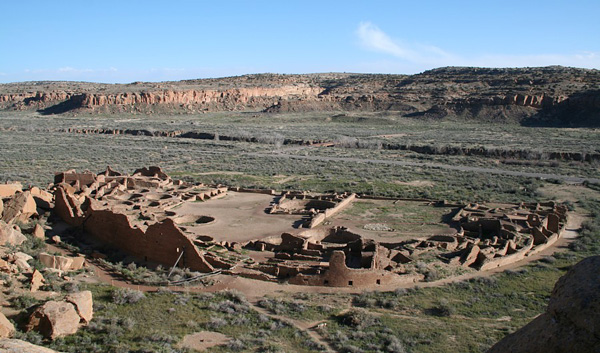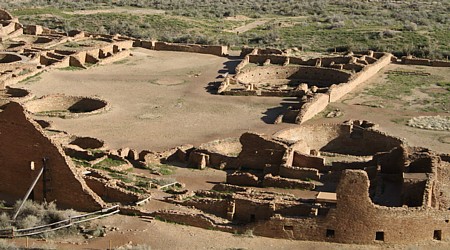
Rimrock view of Pueblo Bonito.
For over 2,000 years, the Pueblo people occupied a region of the United States in the south western section sometimes referred to as Oasisamerica. These ancient peoples built settlements, called Pueblos, with huge many roomed buildings and grand ceremonial plazas. Elaborate road- like networks connected the Pueblos, which extend east onto the Great American Plains. During this time Pueblo Bonito, Spanish for beautiful town, was built and used over a period of approximately 300 years, between 850 A.D and 1200 A.D. The site seems to have been evacuated around the end of 1300 A.D.
At the center of Chacoan society, Pueblo Bonito became an important ancestral site and one of the largest Great House sites in the Chaco Canyon region. This site is known as the main center of the Pueblos living in the region of Chaco Canyon. This archaeological site was actually found by a United States army lieutenant during a military expedition. Covering more 3 acres, this was quite an intricate setup.
Pueblo Bonito has a semicircular shape, with clusters of rectangular shaped sections that were used as rooms for living ad storage. There are more than 800 of these rooms that are enclosing a central plaza. In this central section of the site, kivas were built. Kivas a chambers that are partially placed in the ground, for the purpose of ceremonies, such as contacting their ancestors or spirits. Near the center of the pueblo was a hidden chamber, six feet long by six feet wide, which was only accessible through a small hatch in the roof.
Archaeological findings show a surprising lack of domestic activities in many rooms. There were 32 kivas built, and 3 great kivas, and with in those, there were evidence of communal ritual activities, such as feasting. This leads historical archaeologist to believe that the Pueblo Bonita held an important role in religious, political and economic functions within the Chacoan society.

The Great Kiva in the West Plaza is in the foreground,
the larger Great Kiva adjoins the North-South wall to the south.
I mentioned before that there were small hidden chambers found. In one of these chambers skeletal remains were found. Excavation and DNA research tells us that over a dozen people were buried in here, and that they were most likely members of a powerful Native American dynasty, related through their mothers.
We learned about this site and some of the other pueblo sites found in the south western section of America. I was very interested and wanted to find out a little more research about these sites, Pueblo Bonito in particular. Archeaology can tell amazing stories about the past that is not often told or written. This is very important because it can teach us important information, such as, how they kept unity, how and when religious practices started being used, diets that they ate. Basically how they survived and then we can learn off of the findings.
More information on Chaco Culture
https://whc.unesco.org/en/list/3
References and further Reading
https://news.nationalgeographic.com/2017/02/chaco-canyon-pueblo-bonito-room-33/
https://www.thoughtco.com/pueblo-bonito-chaco-canyon-great-house-172140
http://www.chacoarchive.org/cra/chaco-sites/pueblo-bonito/
https://en.wikipedia.org/wiki/Pueblo_Bonito#Discovery
Picture References
http://www.jqjacobs.net/southwest/pueblo_bonito.html

I wanted to know if you could speak more to the part where you discuss the findings from the secret room in the center. What type of DNA testing did they do? How do they know based on their mothers DNA? How did they get that?
Thank you for your questions!
We know from class readings and discussions that they can find which race you are from certain skeletal characteristics and entering measurements of the remains into a system that compares that data with other measurements in the system, to find out which ones they are more similar too.
In doiing some more reseach I found out that the archaeologists here used a couple more methods to dicover the different mother- daughter and grandmother- grandson relationships and the ancestry.
Archaeologists extracted bone collagen from the crania of nine additional individuals and purified it using ultrafiltration. “Crude and ultrafiltered gelatin yields were excellent and stable isotope measurements are consistent with a population relying on maize agriculture” which would be consitant with the Native American culture.
More importantly, they used Microgenomic sequencing. Using archaeogenomic methods, they were abe to reconstruct the mitochondrial DNA genomes. All the genome sequencing was identicall and belonged to a B2y1 haplotype. This B2 haplotype had also been found in Southwest Native Americans.
It is amazing the resources we have to find out ancestry and diet now!
I used this site for the information above, they have more detailed explanations of all the methods and findings at Pueblo Bonito https://www.nature.com/articles/ncomms14115
This link has more infortmation on the human genome
https://www.ncbi.nlm.nih.gov/pubmed/11833767